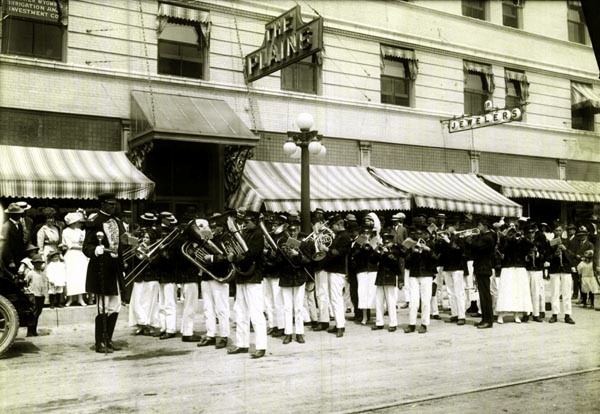
Denver Post Boys Band at 16th Street Entrance to Plains Hotel, Frontier Days Celebration, 1912.
The Denver Post Boys Band at the time was the most famous band in the Rocky Mountain area. It played at least three times at Frontier Days. It played for just about every famous person
that visited Denver and at the
1908 Democratic National Convention in Denver. Contrary to popular belief, it was not composed of newsboys for the Denver Post. It featured Carl Sandell (1891-1865) who at seven foot five inches was referred to as
"the biggest drum major in the world." Sandall later was employed by the Daniels and Fisher Department Store in Denver as a doorman.
Some reference materials describe the Plains Hotel as being in the Art Deco style. Indeed in the
1920's with the additions to the hotel, the building was redecorated in the art deco style as illustrated by
the Wyoming Room and the hotel's bar, both depicted below.
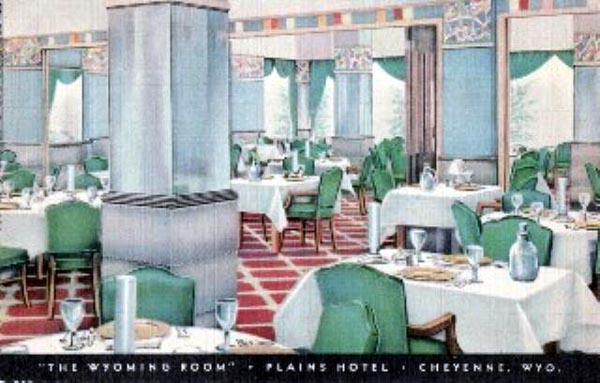
Plains Hotel, the Wyoming Dining Room, approx 1930.
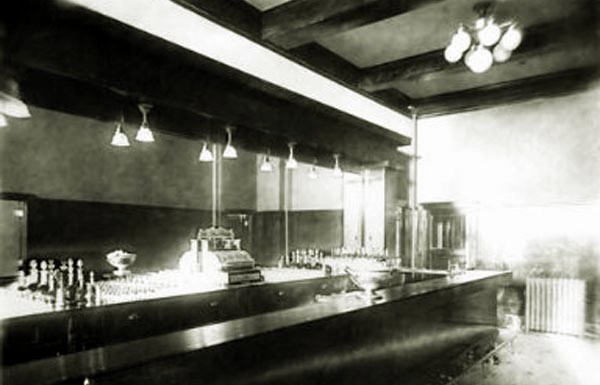
Plains Hotel Bar, undated but prior to 1935.
In the above photo note the cluster lamp and the art deco syle backbar mirror. About 1936-1936 the hotel went another recorations using designs by
Thomas Canada Molesworth of Cody (1890-1977). Molesworth's designs were in the "High Cowboy" style popular in the late 1930's. Molesworth's furniture was used on "Ranch A" in
Beulah, the Wort Hotel in Jackson and other Western themed hotels.
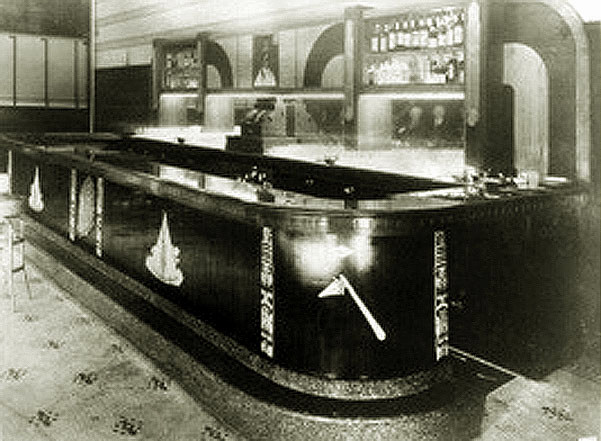
Plains Hotel Bar, as redesigned by Thomas Molesworth, approx. 1936.In addition to the changes to the bar and
back bar mirror, note the change in the lights.
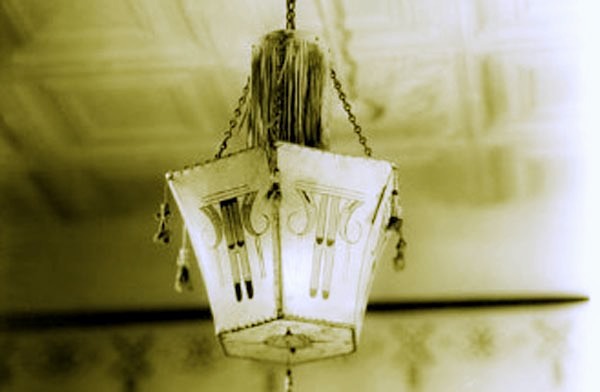
Molesworth ceiling light, Plains Hotel, approx. 1936.
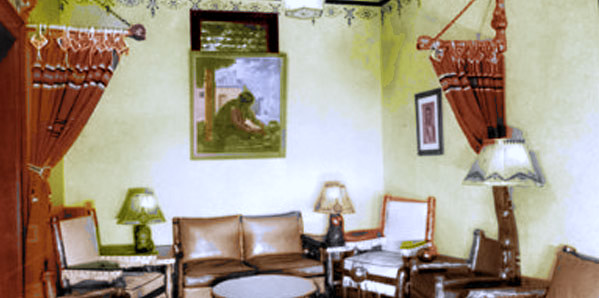
Molesworth furniture, Plains Hotel, approx. 1936.
In the 1930's, 40's and 50's, the Plains hotel in addition to the Wyoming Room, also had the Wigwam Room and the Oak Room. The Oak Room featured dining and
dancing. In 1940, United Airlines opened its stewardess training center at Cheyenne Airport. When a new stewardess class arrived in Cheyenne they were
taken to the Wigwam Room to have their pictures taken at the photography shop next door. Thus, the stewardesses were early introduced to the two venues. Additionally, during World War II,
the hotel basically booked only female entertainers. Billboard Magazine, Aril 2, 1943, p. 18, noted that Max Cooper
was the first male entertainer booked into the Oak Room in over a year. His four piece band did, however, headline
the "dynamic girl accordianist Yolanda." Undoubtedly, during the years 1943-44 one of the most popular groups in the
Oak Room was Maria Karson's Musicales, a four girl band who provided sing-alongs and novelty tunes played on a Hammond
organ, piano, violine, piano, marimbas, and drums. The group was lavishly costumed. Karson's group played in the Oak Room for most of
1943 and 1944 including during two Frontier Days celbrations. Because of the number of troops at
Fort F. W. Warren, the Oak Room did a land office business. Billboard
Magazine, January 2, 1943, p.60, noted:
CHEYENNE, Wyo. Dec 26 -- Cheyenne night club, bar and restuarant operators are
wondering how mch more the boom will continue. All are filling to capacity several nights a
week, and Saturdays bring them overflow.
The 18,000 troops at Fort Warren, coupled with its airport enlargement and bomber modification center, housing
projects, skyrocketing railroad pay rolls and a 100 octane gasoline plant are the sources of the boom.
Most popular nights spots here are the Plains Hotel Oak Room,
Valecia, Mayflower, Araby and Plamor clubs.

Maria Karson and the Musicales, approx. 1943.
In the 1930's as a part of the renovations and additions to the hotel, an old passageway from Capitol Avenue to the rear of the Majestic Building, was refitted as an additional
entrance into the Plains Hotel.
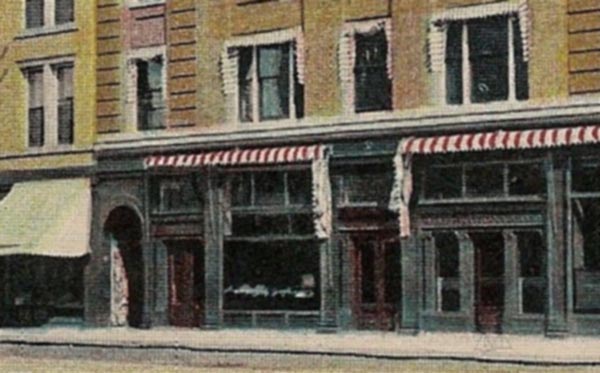
The arch to the right of the awning was the old passageway to the
rear of the Majestic Building.
For those seeking the Oak Room or the Wigwam Room, the passageway provided an inconspicuous entrance without running the gauntlet of the lobby.
Some unknown wag, in a flash of delicious sarcasm, dubbed the hallway "Peacock Alley." The name may have been
inspired by a movie of the same name or perhaps, more likely,
after the grand prominades at the the Congress Hotel in Chicago, the New Willard in Washington D.C. or the original three hundred foot long
prominade connecting the old Astoria Hotel with the old Waldorf Hotel in New York. Other grand prominades such as those at the
Tokyo's Imperial Hotel or prior to World War II, the "Grand Hall" in Shanghai's old Shanghai Club on the Bund were likened to
the original Peacock Alley. On the second floor, the Shanghai Club was the world's longest bar. Indeed, it was so long that Sir NoŽl Coward allegedly claimed that
he could put his cheek on the bar and see the curvature of the earth. One's position at the bar was dependent upon one's social
standng. Senior business executives of major British trading companies were at one end. The lower one's status the further away down the bar one stood.
In New York, the original Peacock alley was some three hundred feet long connecting the
Astoria and the Waldorf. It was decorated in a gilded Egyptian Revival style. The
movers and shakers of the world strutted its lenth in formal attire and silk hats accompanied by bejeweled women. The Alley supposedly
received its name from the society editor of the New York Herald who commented, "Look at them strutting and
preening along the corridor, just like peacocks."
Some who strolled down
the prominade included Prince Henry, the heir to the German Imperial Throme; the Prince of Wales, later Edward VII;
Admiral Dewey fresh back from a cuise to Manila Bay; Prince Carol of Romania; President McKinley; Marshal Foch of France and "Bet a Million" Gates.
Allegedly, Mark Twain in his later years after he switched to wearing a white suit in both winter and summer
liked to make his grand entrance down the Alley. Others came just for the show. Lloyd Wendt and Heman Kogan, The Story of John W. Gates, Bobbs-Merrell Comany, 1948, p. 215, quoted
journalist E. M. Kingsbury (New York Sun and New York Times) as describing the others:
The little clerks in their little dress suits swarm from their little half
bedrooms to go and watch the millionaires, to breathe the atmosphere of
money, to talk loudly of mythical deals. Strangers and countrymen flock
there to look at the show and be conducted through those halls of gewgaws.
Women of all sorts and conditions are there to see and be seen, get some
sort of golden halo. Bulls, bears, foxes, even badgers abound. The shabby
genteel strut around lonely, but happy. They think they are getting social
consecration. Everybody is hunting somebody or something, pleasure,
notoriety, adventure, money most of all. Poor folks eat and drink beyond
their means, intoxicated by the luxury and show of wealth.
The hallboys have inside information on the stock market. The maids have
diamonds to lose. The head waiter is the familiar friend of the financial
magnates.
.
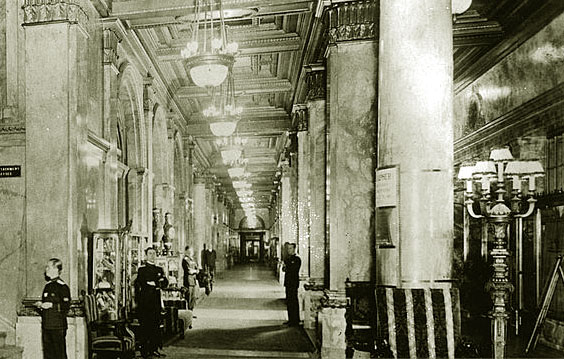
Peacock Alley, Waldorf Hotel, New York, c. 1910.
The fame of Peacock Alley was such that any grand prominade was called a
"peacock alley." Indeed, Two movies were named after the original alley, as well as several songs,
"Peacock Rag" and "Peacock Strut"
The original Waldorf and Astoria hotels closed on May 9, 1929, to make way for the Empire State Building on its site.
In due course, a new Waldorf opened. It featured a Peacock Alley Restuarant.
The new Peacock Alley at the Waldorf is still where poor folks, at least old cowboys,
can eat and drink beyond their means, but such is the American tax system where one may deduct the cost of extravagnt meals when one is
doing business in the restaurant or bar. As of 2016 at the Waldorf, the cost of a house-made cranberry infused vodka, Marie Brizzard apricot brandy fresh sour was $19.00.
bottled beer was $9.00.
At the Plains, the name "Peacock Alley" stuck. The alley was less than a grand or pretentious prominade. It was in fact a plain, back hallway with
painted brick walls and without grandiose decorations. Indeeed it had no decorations at all except maybe the pattern in the floor. It
reminds one of a baement corridor in some university or government building.
During World War II, eighteen thousand troops at F. E. Warren, along with hundreds more employed at the railyards, the refinery and the bonber modification facility,
not counting rodeo cowboys during Frontier Days, flocked like so many peacocks in heat to the Plains'
alley vieing for the attention of maybe sixteen stewardesses and members of four-girl bands.
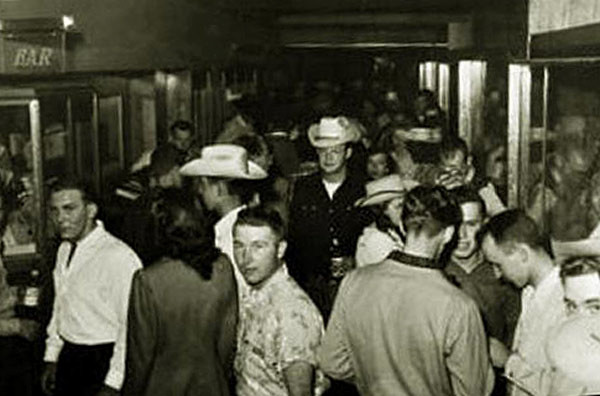
Young men in hallway outside Plains Hotel Bar.
In 1961, United Airlines moved its stewardess training center out of Cheyenne relieving the congestion in the tight, little corredor.
Nevertheless, the hallway leading into the Plains Hotel bar has retained the name "Peacock Alley."
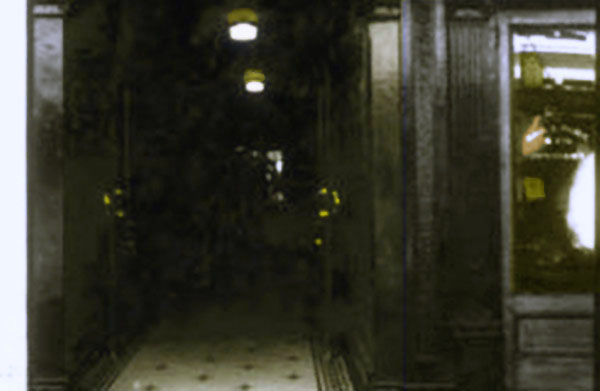
Peacock Alley.
In recent years, the Plains has again been renovated bringing back its glory. The Wigwam room closed in 2000 in favor of a coffee shop.
It has since been brought back as the
Wigwam Room II.
Background music this page, "The Peacock Strut," composed in 1917 by Lou China Frisco for Xylophone and
string orchestra.
Union Pacific Depot continued on next page.
|